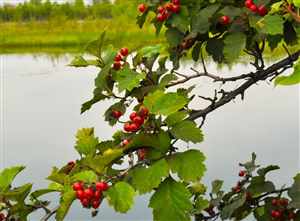Hawthorn (Crataegus)
Main Facts about Hawthorn

Using Hawthorn
Hawthorn berries have been shown to have a tonic effect on the heart. They are often used in the treatment of weak heart conditions, especially if this is accompanied by high blood pressure. Antioxidant and bioflavonoid rich, good for cardiovascular system, gentle but powerful, contains numerous phytochemicals that make heart more efficient pump, increasing output of blood from the heart, and decreasing resistance from blood vessels, therefore making it great for both high and low blood pressure, angina, cardiovascular circulation. Reduces cardiac arrhythmia (irregular heartbeat) and tachycardia (racing heartbeat). Hawthorn is also famed to promote the digestion of meat and fatty foods. The presumed mechanism of action is to stimulate the production or activities of enzymes that digest these food substances and/or stimulate production of bile, which especially assists the digestion of fats. Some people use hawthorn for digestive system complaints such as indigestion, diarrhea, and stomach pain. It is also used to reduce anxiety, as a sedative, to increase urine output, and for menstrual problems. Hawthorn is also used to treat tapeworm and other intestinal infections. It can be applied to the skin for boils, sores, and ulcers. Hawthorn preparations are used as a wash for sores, itching, and frostbite.Hawthorn is a remedy for: Anxiety
Cooking with Hawthorn
You can eat the berries straight off the tree, but don’t eat the seeds. They contain cyanide bonded with sugar, called amygdalin.You can cook the berries then discard the seeds. For maximum nutritional value, eat the berries raw if you like it. If you eat the raw berries spit the seeds out. It is also possible to dry them for later use, or to cook them for use in preserves etc. The leaves are not strongly flavoured, but make a pleasant addition to salads. Herbalists say two teaspoons of leaves or seedless berries (or both) made into a tea twice a day is an effective beta blocker and lower blood pressure.How to grow Hawthorn
In general they prefer a well-drained but moisture-retentive loamy soil, but they will succeed in most other situations including heavy clays and very chalky soils. Once established they are quite drought tolerant, though they will also tolerate quite wet soils and some species succeed even where the water stands in winter. Many species are also very wind tolerant, some of them succeeding in maritime exposure, and they can be included as part of a shelter-belt planting. They are also tolerant of atmospheric pollution and so grow well in towns, cities, by main roads and industrial estates. For the highest fruit production, it is best to grow the plants in as sunny a position as possible, though they will also succeed in semi-shade. A position on the sunny edge of a woodland is ideal.Hawthorn Toxic Look-alikes
none| Grapes |
Hibiscus
|